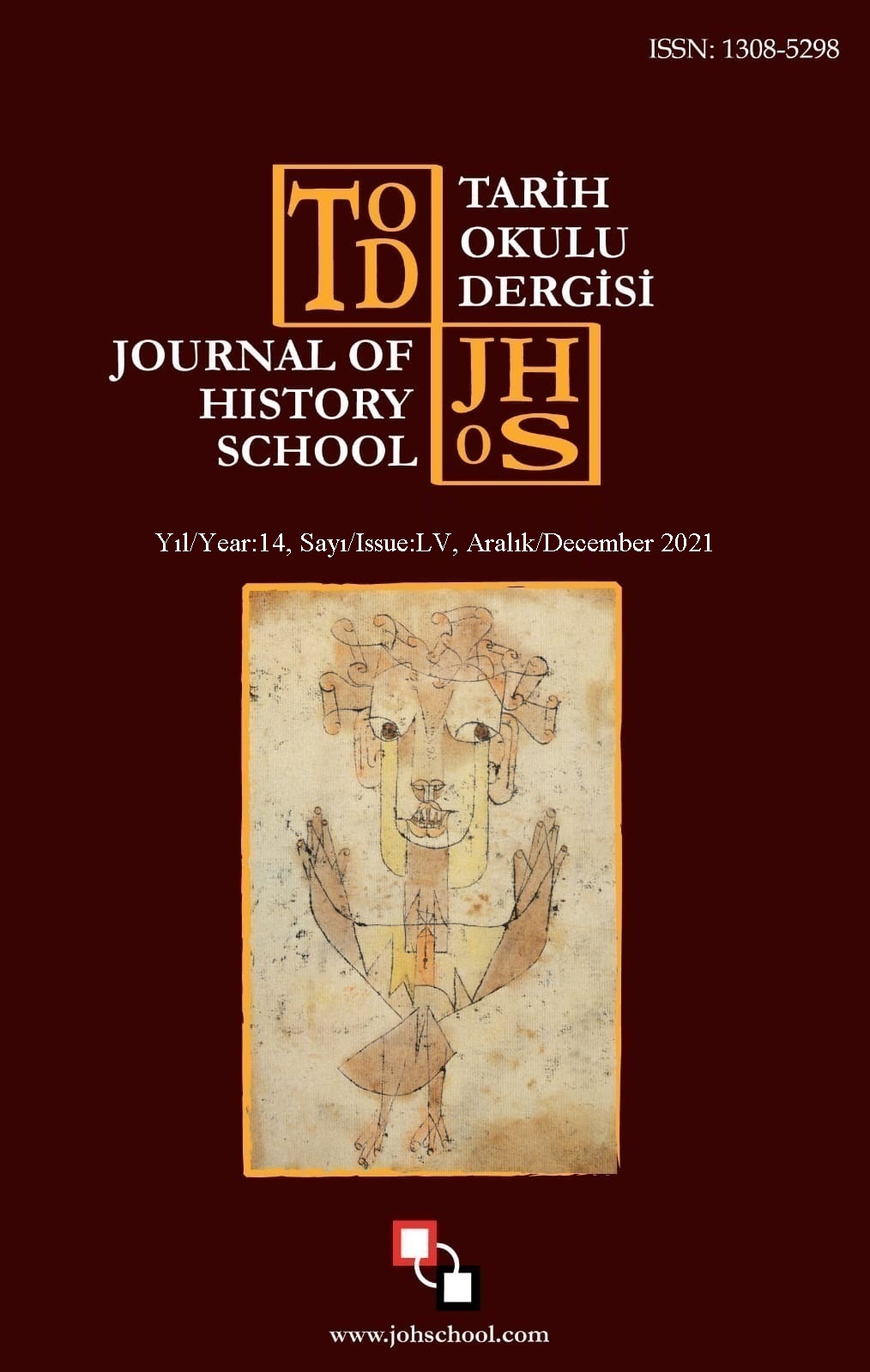Author :
Abstract
Araştırmanın amacı, Mantık dersi alan öğrenciler tarafından Mantık kavramının nasıl kavramsallaştırdığı ve algıladığının, metaforlar aracılığı ile belirlenmesidir. Araştırmada nitel araştırma yöntemlerinden fenomonolojik desen, çalışma grubu belirlenirken de amaçlı örnekleme tekniğinden faydalanılmıştır. Araştırmada 2020-2021 eğitim-öğretim yılında Bingöl Üniversitesinde Mantık dersi alan öğrencilerden toplam 241 Üniversite öğrencisi yer almıştır. Mantık dersi alan öğrencilere metafor cümlesi online olarak gönderilmiştir. Veriler analiz edilirken “içerik analizi” tekniği kullanılmıştır. Araştırma sonuçlarına göre Mantık dersi alan öğrenciler en fazla “doğruyu yanlıştan ayırt etmesi” kategorisinde metafor üretmiştir (f=29). Mantık dersi alan öğrencilerin ürettiği metaforlar frekans sayısı bakımından; “bilinmeyene ulaştırması, temel gereksinim olması, karmaşık ve zor olması, sistematik ve işlevsel olması, açıklayıcı olması, bütüncül olması, aydınlatıcı ve yol gösterici olması, faydalı olması, eğlenceli olması, değerli olması ve insan tabiatına uygun olması” gibi toplam 12 kategori başlığı altında yer aldığı görülmüştür. Öğrencilerin ürettikleri metaforlara bakıldığında, genellikle mantık dersi alanların mantık hakkında doğru bilgiye sahip oldukları görülmektedir. Başka çalışmalarla yapılan karşılaştırmalarda, mantık dersi almayan öğrencilerin mantık ile ilgili bilgi performanslarının düşük olduğu gözlemlenmiştir. Mantık bilimi hakkında öğrenciler, mantığın tanım ve işlevselliğiyle ilgili metaforlar ürettikleri tespit edilmiştir.
Keywords
Abstract
The aim of the research is to determine how the students taking Logic lesson conceptualize and perceive the concept of Logic through metaphors. In the study, phenomenological design, one of the qualitative research methods, was used, and purposeful sampling technique was used to determine the study group. A total of 231 university students from the students who took Logic course at Bingöl University in the academic year of 2020-2021 took part in the research. The metaphor sentence was sent online to the students taking logic lessons. The "content analysis" technique was used to analyze the data. According to the results of the research, the most metaphors in the category of "leading to thinking" were produced by the students who took the Logic course (f = 29). The metaphors produced by the students taking the logic lesson in terms of the number of frequencies; It is included in a total of 12 categories, such as "to the unknown, to be basic need, to be complex and difficult, to be systematic and functional, to be explanatory, holistic, enlightening and guiding, useful, entertaining, valuable and suitable for human nature". It has been seen to take. When the metaphors produced by the students are examined, it is seen that those who take logic courses generally have correct knowledge about logic. In comparisons with other studies, it was observed that students who did not take logic courses had low knowledge performance about logic. It has been determined that students produce metaphors about the definition and functionality of logic.
Keywords
- Arslan, M., & Bayrakçı, M. (2006). Metaforik Düşünme ve Öğrenme Yaklaşımının Eğitim öğretim Açısından İncelenmesi. Milli Eğitim Dergisi, 171, 100-108.
- Ayık, H. (2009). Düşünceden dile felsefe ve metafor, milel ve nihal inanç. Kültür ve Mitoloji Araştırmaları Dergisi, 6(1), 54-75.
- Başerer, D. (2006). Öğretmen Adaylarının Mantık, Özdeşlik, Doğru, Gerçeklik, Tutarlılık, Çelişki Kavramlarını Anlama Düzeyleri (Gazi Eğitim Fakültesi Örneği), Yüksek Lisans tezi, Gazi Üniversitesi Eğitim Bilimleri Enstitüsü.
- Bletzer, K. V. (2015). Visualizing the qualitative: making sense of written comments from an evaluative satisfaction survey. Journal of Educational Evaluation for Health Professions, 12, 12.
- Büyüköztürk, Ş., Kılıç, E. Ç., Akgün, Ö.E., Karadeniz, Ş., & Demirel, F. (2008). Bilimsel Araştırma Yöntemleri. Pegem Akademi Yayıncılık.
- Çaldak, H., & Demirbilek, N. (2021). Metaphoric Perceptions of Philosophy Students on the Concept of Philosophy, Beytulhikme An International Journal of Philosophy, 11(2), 979-997.
- Çaldak, H. (2015). Öğretmen adaylarının mantıksal düşünmeye ilişkin algıları. Bingöl Üniversitesi Sosyal Bilimler Enstitüsü Dergisi, 5(10), 63-71.
- Çalışkan, N. (2009). Metaforların izinde bir yazarın kavramlar dünyasına giriş: cemil meriç’in bu ülke ’sinde kitap metaforları. Dil Araştırmaları 4, 87100.
- Cerit, Y. (2008). Öğretmen kavramı ile ilgili metaforlara ilişkin öğrenci, öğretmen ve yöneticilerin görüşleri. Türk Eğitim Bilimleri Dergisi, 6(4), 693 – 713.
- Creswell, J. W. (2017). Araştırma Deseni Nitel Nicel ve Karma Yöntem Yaklaşımları. Çev. S. B. Demir, 3. Basım, Anı Yayıncılık.
- Demirbilek, N. (2020). Üniversite öğrencilerinin gözüyle üniversite kavramı. OPUS Uluslararası Toplum Araştırmaları Dergisi, 16(Eğitim ve Toplum Özel Sayısı), 5585-5607.
- Demirbilek, N. (2021). Üniversite öğrencilerinin kayırmacılık kavramına ilişkin metaforik algıları. Yaşadıkça Eğitim, 35(2), 367-381.
- Demirbilek, N., & Atila, F. (2021). Üniversite öğrencilerinin perspektifinden sanal kaytarma kavramı. Adıyaman Üniversitesi Sosyal Bilimler Enstitüsü Dergisi, 38, 196-222.
- Demirbilek, N., & Han, F. (2021). Examination of school managers' metaphorical perceptions regarding the concept of "educational management. Journal of History School, 52, 1885-1905.
- Demirbilek, N., Han, F., Demirtas, & H., Atila, F. (2021). Okul yöneticisi ve öğretmenlerin bakış açısıyla uzaktan öğretim kavramı. İnönü Üniversitesi Eğitim Fakültesi Dergisi, 22(1), 446-470.
- Demir, C., & Yıldırım, K. Ö. (2019). Türkçede Metaforlar ve Metaforik Anlatımlar, Afyon Kocatepe Üniversitesi Sosyal Bilimler Dergisi, 21(4), 1085-1096.
- Duman, E. Z., Arslan, A., & Küçükşabanoğlu, Ö. (2018). Üniversite Öğrencilerinin “Mantık” Kavramına İlişkin Metaforları, Abant İzzet Baysal Üniversitesi Eğitim Fakültesi Dergisi, 18(3), 1456-1473.
- Emiroğlu, İ. (2011). Klasik Mantığa Giriş. Anı Yayıncılık.
- Ersoy, A. F. (2016). “Fenomenoloji”, Ed. Ahmet Saban ve Ali Ersoy, Eğitimde Nitel Araştırma Desenleri, (1. Baskı içinde). Anı Yayıncılık.
- Fârâbî, (1986), İhsâul’-Ulum (İlimlerin sayımı), Çev. A. Ateş
- Lakoff, G., & Johnson, M. (2015). Metaforlar: Hayat, Anlam ve Dil (Çev. GY Demir). Paradigma.
- Köz İ. (2002). Aristoteles Mantığı ile Felsefe-Bilim İlişkisi, AÜİFD, XL/LL, Sayı 2.
- Keklik, N. (1984). Felsefe bakımından metafor. İstanbul Üniversitesi Felsefe Arkivi Dergisi, 17-18.
- Miles, M. B., & Huberman, A. M. (1994). Qualitative Data Analysis: An Expanded Sourcebook. Sage.
- Schram, T. H. (2003). Conceptualizing Qualitative İnquiry: Mind work for Fieldwork in Education and the Social Sciences. Upper Saddle River, NJ: Merrill Prentice Hall.
- TDK. (2011). Metafor md.
- Yıldırım, A., & Şimşek, H. (2016). Sosyal Bilimlerde Nitel Araştırma Yöntemleri. 10. Basım, Seçkin Yayıncılık.
- Yıldırım, C. (1976). 100 Soruda mantık El Kitabı.





